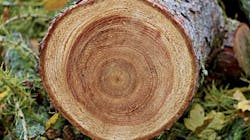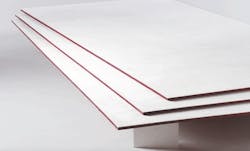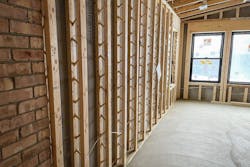With its high strength-to-weight ratio, wood makes for an awesome structural material. But because of its limitations—fire performance and moisture sensitivity among them—it sometimes needs help to perform at its best.
Manufacturers have been doing their part for decades, and more help is on the way from academia: Montana State University (MSU) recently announced it is currently engaged in a study to find ways to improve the strength of standard dimensional wood structural members.
Eliminating Wood’s Structural Weakness
Wood’s strength, elasticity, and durability increase as its density increases, and a great deal of research has looked at the inherent variability of wood density within species.
MSU’s research aims to improve the strength of wood as a structural material, with the hope of contributing to the trend of using wood instead of steel for beams in high-rise buildings and other structures.
“Tiny air pockets interspersed in wood’s cellular structure are what cause it to float,” the university said in a press release. “They also produce the satisfying crackle when wood is burned. But when wood is turned into structural lumber—the material’s most widespread and valued use—the air pockets become a source of weakness.”
MSU researchers are trying to fill those tiny voids to improve the material’s strength. “This is the first study of its kind,” said Dilpreet Bajwa, professor in the university’s Department of Mechanical and Industrial Engineering at the Norm Asbjornson College of Engineering.
RELATED
- What to Select? Wood vs. Engineered Lumber
- Lumber Prices Hit Record High, Threatening Housing's Momentum
- 5 Proven Ways to Optimize Construction Framing
University Research to Increase Wood’s Structural Strength
During the process, Bajwa and his team fill the tiny voids with cellulose nanocrystals, which they make by breaking down wood or crop biomass. Cellulose, the university says, is what gives plant cells their stiff structure. By processing woody material and separating the cellulose, the result is hard crystals that are so small they’re measured in nanometers. “The crystals are as strong as Kevlar,” Bajwa said, and because they’re so small, the cellulose particles can penetrate and fill the air pockets.
In the lab, the team treats the wood with a chemical solvent that dissolves resin, which may be clogging the wood’s pores, puts the wood samples in an airtight chamber, creates a vacuum that sucks out the solvent, and then injects the nanocrystals into the pores.The solvent then solidifies.
The university says early results have been promising. Bajwa’s team found that nanocrystals doubled the stiffness of one sample and increased the wood’s structural strength by 40%.
Manufacturer Developments and New Wood Products
Building products manufacturers are also doing their part. The engineered wood industry has been improving the properties of wood for years, and this movement continues today.
Wood manufacturers say the building industry can expect to see more high-performance products in the future. Take a look at some of the latest developments:
High-performance subflooring
Based on feedback from construction pros, Huber Engineered Woods developed and added AdvanTech X-Factor subflooring to its line of high-performance structural systems.
In contrast to traditional OSB or plywood panels, which typically flake, delaminate, or discolor from exposure to daily jobsite stresses, X-Factor includes a built-in protective top layer that increases the moisture-resistance of the original AdvanTech panel. That built-in, fade-resistant, water-shedding layer not only protects the quality and appearance of the panel surface, the company says, but also provides a smooth subfloor surface that’s easy to clean. The 23/32-inch-thick panels are available in 4-by-8-foot panels and can span joist schedules measuring 24 inches on center.
Structural, fire-rated OSB panels
LP Building Solutions’ FlameBlock line of fire-rated sheathing takes a standard OSB panel and adds the manufacturer’s proprietary non-combustible, fiberglass-reinforced Pyrotite treatment. The result is a structural panel with a Class A Flame Spread Rating for 1- and 2-hour fire-rated wall assemblies and roof deck applications. The 1/2-inch-thick panels come in 4-foot widths and 8-, 9-, and 10-foot lengths.
A replacement for the 2-by-6
The BareNaked Tstud system consists of pieces of dimensional lumber cross-linked with dowels to help eliminate thermal bridging. Once framed, the wall assembly leaves space for blow-in insulation, such as fiberglass, cellulose, mineral wool, or a spray-in open- or closed-cell foam, which helps to create a continuous layer of insulation in the field without exterior foam board. An R19 Tstud product is also available, which includes closed-cell foam insulation pre-applied between the studs.
Enhanced OSB for roofing
DryGuard Enhanced OSB Sheathing panels from Georgia-Pacific offer improved moisture resistance from the elements throughout the panel and feature a black edge seal that helps to prevent moisture intrusion at the edges. The panel protects roofs against water-related issues such as thickness and edge swell, the manufacturer says, and also offers enhanced nail-holding ability, stiffness, and strength.




